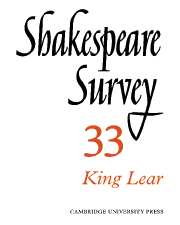Book contents
- Frontmatter
- King Lear: A Retrospect, 1939–79
- Some Conjectures on the Composition of King Lear
- The War in King Lear
- King Lear: Art Upside-Down
- ‘And that’s true too’: King Lear and the Tension of Uncertainty
- The Taming of the Shrew and King Lear: A Structural Comparison
- Medium and Message in As You Like It and King Lear
- Playing King Lear: Donald Sinden talks to J. W. R. Meadowcroft
- Hamlet’s Special Providence
- Antony and Cleopatra: ‘The Time of Universal Peace’
- Patterns of Motion in Antony and Cleopatra
- Theme and Structure in The Winter’s Tale
- Peter Street at the Fortune and the Globe
- English Actors at the Courts of Wolfenbüttel, Brussels and Graz during the Lifetime of Shakespeare
- Shakespeare at Stratford and the National Theatre, 1979
- The Year's Contributions to Shakespearian Study 1 Critical Studies
- 2 Shakespeare’s Life, Times, and Stage
- 3 Textual Studies
- Index
- Plate Section
King Lear: Art Upside-Down
Published online by Cambridge University Press: 28 March 2007
- Frontmatter
- King Lear: A Retrospect, 1939–79
- Some Conjectures on the Composition of King Lear
- The War in King Lear
- King Lear: Art Upside-Down
- ‘And that’s true too’: King Lear and the Tension of Uncertainty
- The Taming of the Shrew and King Lear: A Structural Comparison
- Medium and Message in As You Like It and King Lear
- Playing King Lear: Donald Sinden talks to J. W. R. Meadowcroft
- Hamlet’s Special Providence
- Antony and Cleopatra: ‘The Time of Universal Peace’
- Patterns of Motion in Antony and Cleopatra
- Theme and Structure in The Winter’s Tale
- Peter Street at the Fortune and the Globe
- English Actors at the Courts of Wolfenbüttel, Brussels and Graz during the Lifetime of Shakespeare
- Shakespeare at Stratford and the National Theatre, 1979
- The Year's Contributions to Shakespearian Study 1 Critical Studies
- 2 Shakespeare’s Life, Times, and Stage
- 3 Textual Studies
- Index
- Plate Section
Summary
It is a truism that in King Lear Shakespeare takes us into a world which is upside-down. We enter a great and terrible feast of misrule where the king gives away his kingdom and becomes a subject, where parents become wards of their children, asses are borne on men’s backs over the dirt, and one goes to supper in the morning and to bed at noon. This is ‘the upheaval of all nature, the reversal of all histories’. Approaching such a paradoxical and apparently sprawling piece of art, commentators generally have sought some kind of orientation through imposing a shape or schema on the play. The most recent emblem for King Lear is the prism –‘the multiply-shaped thing’, as it is called in Rosalie Colie’s and Leo Flahiff’s book Some Facets of ‘ King Lear ’: Essays in Prismatic Criticism. As a figure for the play the prism image certainly is superior to the very old-fashioned way of charting a drama as rising action, peak, falling action – the hunt-the-climax pattern which dates back to the 1860s and the German scholar Gustav Freytag. Where, after all, is the ‘climax’ of King Lear? If we should begin to chart it as a ‘rising action’ we might simply find ourselves following it helplessly up and up and up . . .: this play after all qualifies as scene individable and poem unlimited.
- Type
- Chapter
- Information
- Shakespeare Survey , pp. 35 - 42Publisher: Cambridge University PressPrint publication year: 1981



